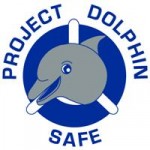 Project Dolphin Safe Assoc Inc. (PDS) was started in 1998 after the brutal killing of 6 Indo Pacific Bottlenose dolphins (Tursiops aduncus), three were shoot, two were stabbed and the sixth died from starvation as her mother was killed weeks earlier.
Project Dolphin Safe Assoc Inc. (PDS) was started in 1998 after the brutal killing of 6 Indo Pacific Bottlenose dolphins (Tursiops aduncus), three were shoot, two were stabbed and the sixth died from starvation as her mother was killed weeks earlier.
Since such time PDS started actively patrolling the Port River Estuary and surrounding waterways acting as a deterrent from those wanting to inflict harm onto these defenseless animals.
PDS started with a bang thanks to national story and head line on channel Nines “A Current Affairs” – several additional stories followed shortly thereafter both locally and nationally. The killing stopped almost overnight and the famous Port River dolphins were again swimming freely.
Soon after, PDS incorporated several additional objectives that were considered extremely important for the Port River Estuary and included: restoration of sensitive habitats, revegetation, educational presentation, community clean up days and of course 24/7 rescue response.
Within two years of starting Operation Cove Clean – (Mutton Cove) PDS volunteers had removed 71 abandon vehicles, 59 tons of rubbish and had planted over 6000 native trees shrubs and grasses in Mutton Cove – turning this once well known rubbish dump; into now a registered conservation park.
Snowden Beach, Pelican Point, Garden Island, Bio Park and other key/important areas of the Port River Estuary came under attack by PDS volunteers and are still being cared for today.
Over the years and whilst patrolling the Port River Estuary – PDS members would on the odd occasion come across pelicans and other seabirds that were entangled in fishing tackle and all of which required rescuing. As difficult as it was – the job got done and the animals handed over to the Department for Environment and Heritage for treatment.
![]() In 2003 Project Dolphin Safe (PDS) management heard that Australian Seabird Rescue was coming to Adelaide to hold a “seabird rescue” workshop that would assist people in identifying injured seabirds and also provide advice on capture and rehabilitation techniques.
In 2003 Project Dolphin Safe (PDS) management heard that Australian Seabird Rescue was coming to Adelaide to hold a “seabird rescue” workshop that would assist people in identifying injured seabirds and also provide advice on capture and rehabilitation techniques.
Several PDS officials attended that workshop and immediately started South Australian Seabird Rescue (SASR) as a sister initiative of PDS due to the pre-existing infrastructure, man power, knowledge of the local water ways, constitution, accounts etc.
Within months of starting SASR, the phones were ringing non stop for injured pelicans and other seabirds and PDS – SASR was soon known to be the ones to call when marine wildlife needed assistance.
Several months later it was obvious that this was no longer a “back yard” operation and that we required some assistance. Every government department that PDS had dealt with whilst cleaning up Mutton Cove and other areas of the Port River Estuary were asked if they could assist by way of unused land for a rehabilitation facility – all of which said no.
PDS management then contact AGL Torrens Island Power Station and were welcomed with open arms. PDS was provided with land on which to build on and the use of a Marine Biology Office that was no longer being used. PDS then build the first of its kind in Australia – natural wetland facility for injured marine wildlife to rehabilitate in and since then, this amazing facility has seen hundreds of seabirds, seals and turtles pass through with amazing recovery time and the ability to maintain the wildness needed to survive in their natural environment without the worry of human imprinting.
PDS had now outgrown its name and the names PDS and SASR no longer accurately reflected the overall scope of what we did on a day to day basis; hence AMWRRO was announced in 2010.